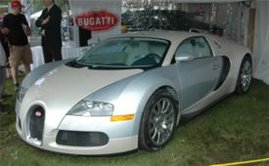Development of the vehicle began with the 1999 EB 18/4 "Veyron" concept car. Introduced at the Tokyo Motor Show, it was similar in design and appearance to the final Veyron production car. One major difference was the EB 18/4's use of a W18 engine with three banks of six cylinders. The Veyron's head designer was Hartmut Warkuss with exterior designed by Jozef Kabaň of Volkswagen rather than Giorgetto Giugiaro of ItalDesign who had handled the three prior Bugatti concepts.
VW chairman Ferdinand Piëch announced the production Veyron at the 2000 Geneva Motor Show. It was promised to be the fastest, most powerful, and most expensive car in history. Instead of the W18, the production model would use a VR6/WR8-style W16 engine. First seen in the 1999 Bentley Hunaudieres concept car, the W16 would get four turbochargers, producing a quoted 1001 horsepower (see engine section for details on the power output). Top speed was promised at 403 km/h (250.4 mph), and pricing was announced at €1 million (US$1.3 million at the time).
Development continued throughout 2001 and the EB 16/4 Veyron was promoted to "advanced concept" status. In late 2001, Bugatti announced that the car, officially called the Bugatti Veyron 16.4, would go into production in 2003. However, the car experienced significant problems during development. Achieving the required high-speed stability was difficult - one prototype was destroyed in a crash and another spun out during a public demonstration at the Monterey Historics event in Mazda Raceway at Laguna Seca. Production of the Veyron was delayed pending resolution of these and other issues.
Piëch retired that year as chairman of the Volkswagen Group and was replaced by Bernd Pischetsrieder. The new chairman promptly sent the Veyron back to the drawing board for major revisions. Neumann was replaced as Bugatti president by Thomas Bscher in December 2003, and substantial modifications were made to the Veyron under the guidance of former VW engineer, Bugatti Engineering head Wolfgang Schreiber.
After the release of the car, it has been reported that while each Veyron is being sold for £840,000, the production costs of the car are approximately £5 million per vehicle. This is not the price to produce one vehicle, but rather the cost of the entire Veyron project divided by the number of vehicles produced at that time. As Bugatti, and therefore Volkswagen, are making such a loss, it has been likened by automotive journalist Jeremy Clarkson and his Top Gear program team in their story on it to the Concorde, in that both were test-beds for advancements in technology and developed as exercises in engineering rather than profit.
In the case of the Veyron, it will be several years before Volkswagen will be able to see if their investment in developing ground-breaking technology has paid off. One key measure is how much (if any) of the technology developed for the Veyron finds use in mass-produced cars.
Subscribe to:
Post Comments (Atom)

No comments:
Post a Comment